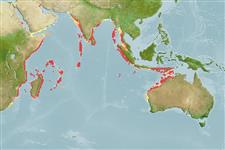Issue
Emily Repair country records.
Environment: milieu / climate zone / depth range / distribution range
Ecology
Marine; brackish; reef-associated. Tropical
Western Indian Ocean: Mozambique, Mauritius, Reunion (Ref. 54356), and Seychelles. Probably more wide-ranging in the area. Western Central Pacific: Guam (Ref. 35720) and Australia (Ref. 2334).
Length at first maturity / Size / Weight / Age
Maturity: Lm 35.0 range ? - ? cm
Max length : 60.0 cm SL male/unsexed; (Ref. 37792)
Occurs in coral reefs. Diet consisted a high proportion of the green alga, Caulerpa.
Life cycle and mating behavior
Maturities | Reproduction | Spawnings | Egg(s) | Fecundities | Larvae
Randall, J.E., 2001. Surgeonfishes of Hawai'i and the world.. Mutual Publishing and Bishop Museum Press, Hawai'i. 123 p. (Ref. 37792)
IUCN Red List Status (Ref. 130435)
Threat to humans
Harmless
Human uses
Tools
Special reports
Download XML
Internet sources
Estimates based on models
Preferred temperature (Ref.
123201): 24.5 - 29, mean 27.5 °C (based on 294 cells).
Phylogenetic diversity index (Ref.
82804): PD
50 = 0.5000 [Uniqueness, from 0.5 = low to 2.0 = high].
Bayesian length-weight: a=0.01995 (0.00906 - 0.04395), b=3.00 (2.82 - 3.18), in cm total length, based on LWR estimates for this Genus-body shape (Ref.
93245).
Trophic level (Ref.
69278): 2.0 ±0.00 se; based on food items.
Generation time: 2.6 ( na - na) years. Estimated as median ln(3)/K based on 1
growth studies.
Resilience (Ref.
120179): Medium, minimum population doubling time 1.4 - 4.4 years (tm=4; K=0.428; Tmax=25).
Fishing Vulnerability (Ref.
59153): Low to moderate vulnerability (33 of 100).
Nutrients (Ref.
124155): Calcium = 37.1 [21.6, 74.3] mg/100g; Iron = 0.587 [0.284, 1.028] mg/100g; Protein = 19 [18, 20] %; Omega3 = 0.138 [0.084, 0.262] g/100g; Selenium = 40.8 [20.9, 80.9] μg/100g; VitaminA = 36.2 [10.4, 119.7] μg/100g; Zinc = 1.59 [1.07, 2.32] mg/100g (wet weight);
